Up until recently, I’ve been freezing our berry harvest for the simple fact that I never had enough at one time to do much with.
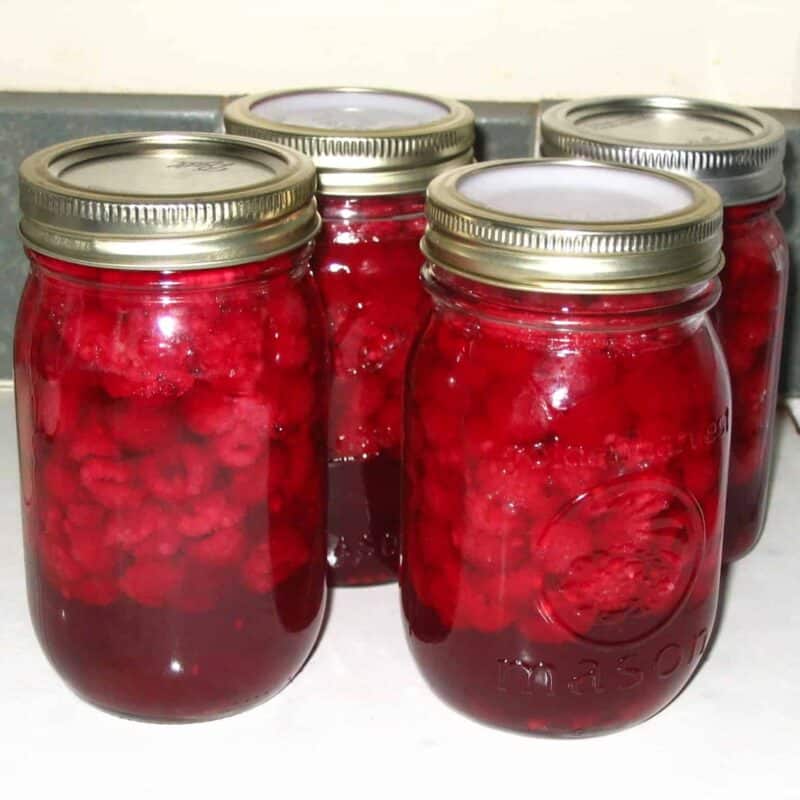
But, lately, our raspberry bushes have been producing quite a lot, and I’ve been able to harvest enough in one day to justify a canning session.
In case you are wondering, we have Red Everbearing Heritage Raspberries. We planted 12 of them one year ago, and they’ve grown like crazy.
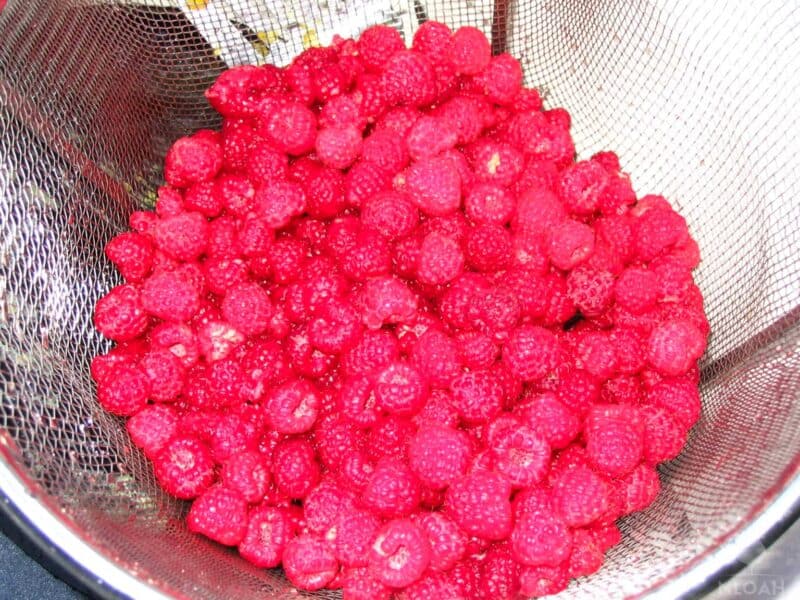
Canning whole raspberries is a great alternative to making raspberry jam because you can use them just as you would fresh berries. I like mine in smoothies, cobblers, and other baked goods.
Why You Should Can Raspberries
Canning raspberries is a simple process, and it allows you to preserve the fruit at its peak of ripeness. In addition, canned raspberries can be used in a variety of recipes, from pies and jams to sauces and syrups.
When it comes to canning raspberries, there are several benefits. For one, canned raspberries have a longer shelf life than frozen raspberries. They can be stored for up to a year without losing their flavor or quality. In addition, canned raspberries are easier to use in recipes because they’re already cooked and softened.
Frozen raspberries, on the other hand, require some advance preparation before they can be used in recipes. However, freezing raspberries preserves more of their nutritional value than canning does. So if you’re looking for a way to preserve the nutritional content of raspberries, freezing is the better option.
Should You Use a Water Bath or Pressure Canner for Raspberries?
Raspberries are a delicate fruit that can be difficult to preserve. If not handled properly, they can quickly become mushy and lose their flavor. That’s why it’s important to choose the right canning method for raspberries.
A water bath canner is the best option because it is specifically designed for fruits.
A pressure canner should not be used because the high temperatures can cause the fruit to become mushy. In addition, water bath canning is much simpler and easier than pressure canning. It does not require special equipment or training, and it can be done in a short amount of time.
As a result, water bath canning is the best option for preserving raspberries.
Raw Pack vs. Hot Pack Canning Raspberries
Raw pack canning involves simply packing the fruit or vegetable into a jar and covering it with boiling water. Hot pack canning involves cooking the fruit or vegetable before packing it into a jar.
Both methods have their pros and cons. Raw pack canning is faster and easier, but hot pack canning results in a higher quality product.
The heat from the cooking process helps to release more of the fruit’s natural sugars, resulting in a sweeter, more flavorful raspberry jam.
Hot pack canning also allows you to pack the raspberries more tightly into the jars, resulting in less air bubbles.
This recipe is technically a raw pack since the raspberries aren’t cooked, but you will add a syrup for extra flavor.
How To Can Whole Raspberries Recipe
This recipe for canning whole raspberries is simple and only requires a few ingredients.
You’ll Need:
- fresh raspberries (about 1 1/2 c. per pint jar, roughly)
- sugar (to make a light syrup; you can also use honey)
- pint jars
- lids/rings
- water bath canner
- canning tools: funnel, jar lifter, lid lifter, ladle
Instructions
Step 1. First, rinse your berries well, being careful not to squish them. If they were organically grown, you might want to treat them to remove any possible worms.
Step 2. While the raspberries are draining, make a syrup to can the berries in. I prefer an extra light syrup because I don’t like to use a lot of sugar. In a medium stainless steel pot, mix 5 1/2 c. water with 1 1/4 c. sugar. Bring to medium-high heat, then to a simmer, keeping it hot:
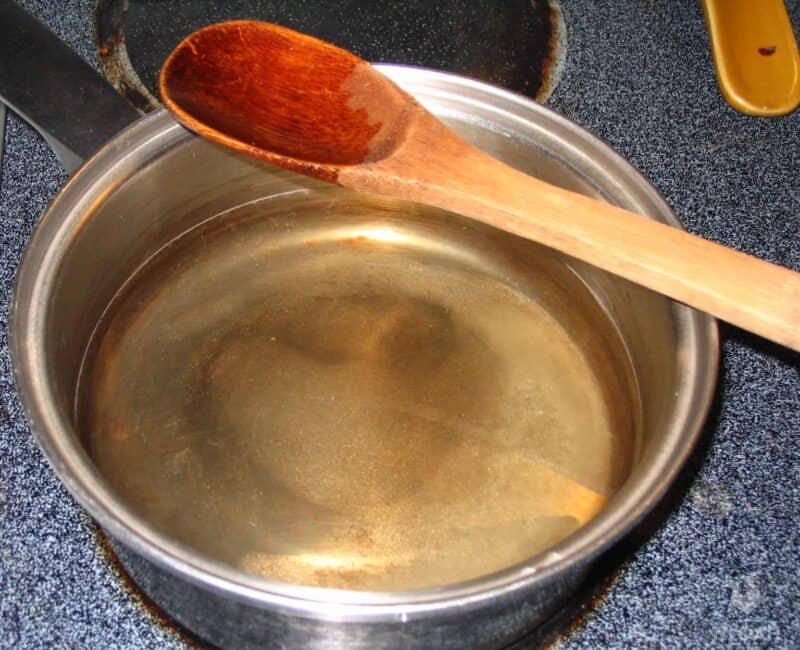
Step 3. Ladle 1/2 cup hot syrup into hot jars. (I run my jars through the dishwasher and keep them in there so they stay hot until ready to use.):
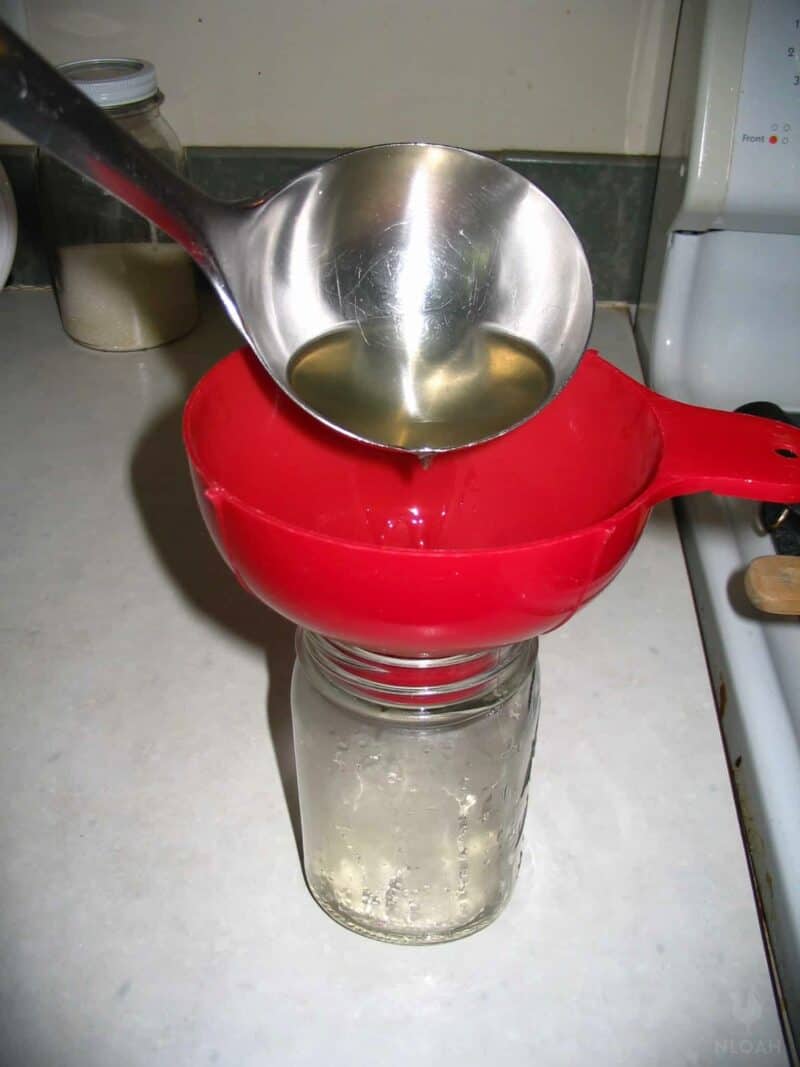
Step 4. Fill the jars with berries, and cover with hot syrup leaving about half an inch headspace (meaning you fill it to within 1/2 in. from the very top of the jar):
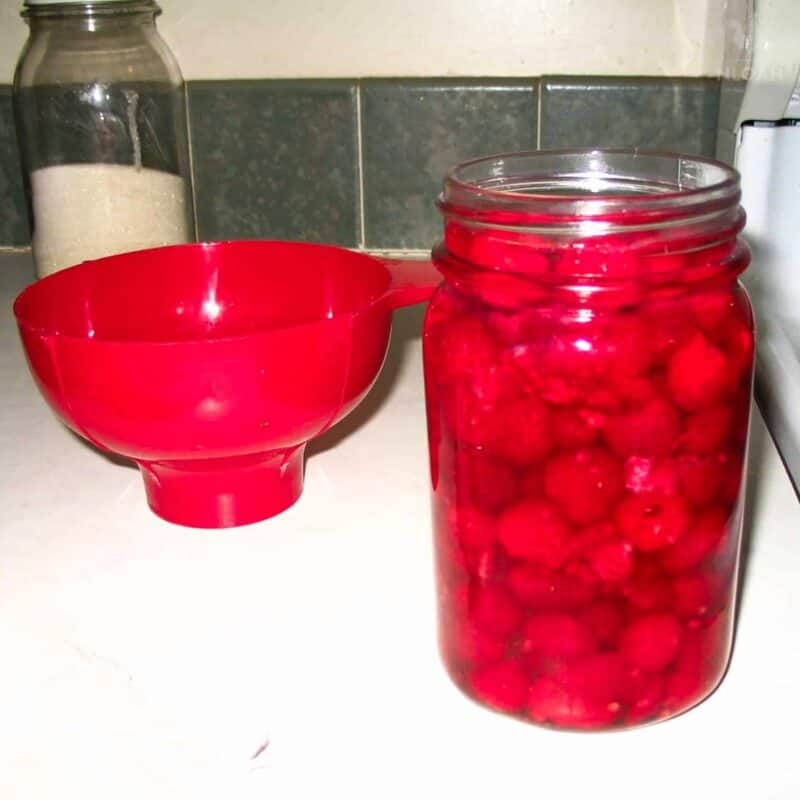
Step 5. Wipe the rim of the jar with a wet rag or towel to remove any possible residue that might prevent the lid from sealing:
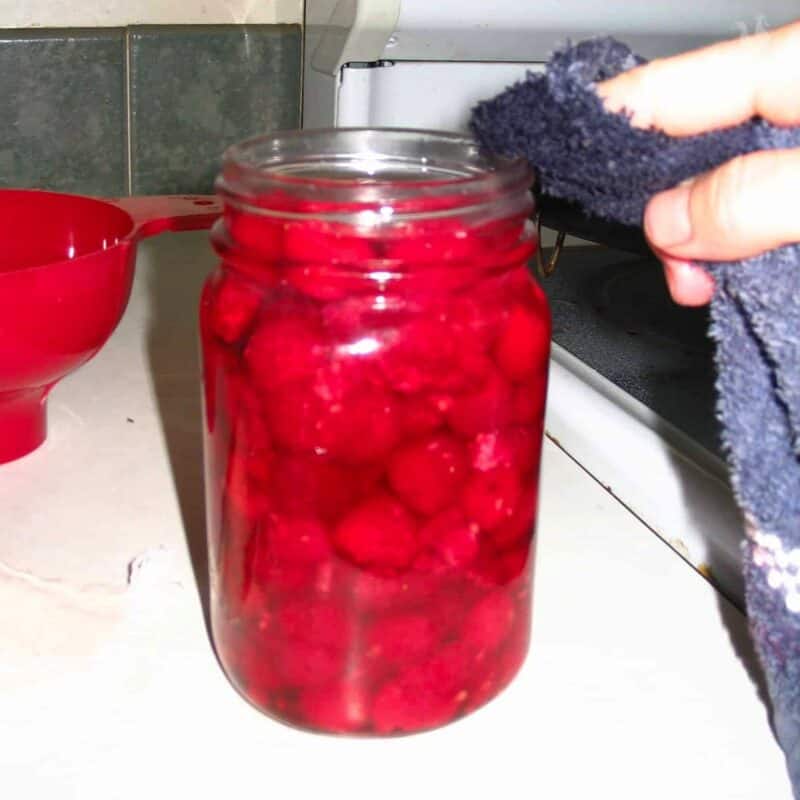
Step 6. Meanwhile, you should have some lids simmering in a small pot of water. They do need to simmer for 15 min. to activate the sealing compound before using:
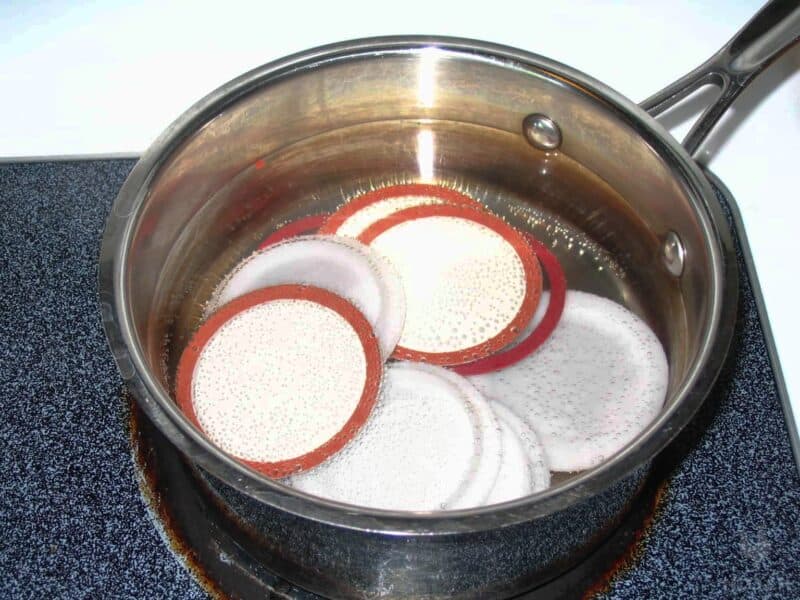
Step 7. Using a lid lifter, grab one of your hot lids out of the simmering water and place it on the jar along with a lid ring:
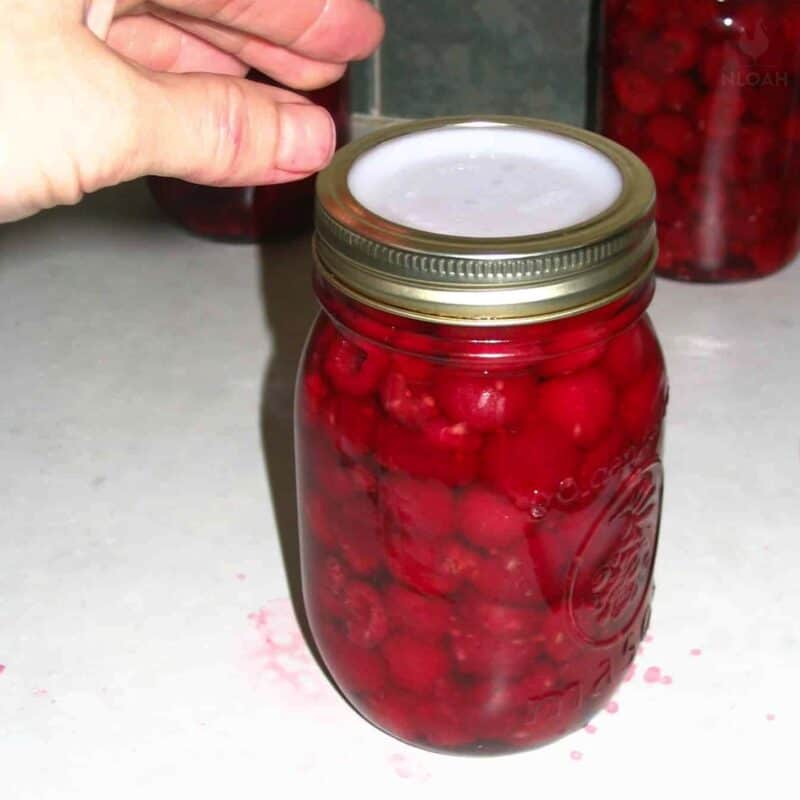
Step 8. Using a jar lifter, lower the filled jars into a boiling water bath canner. The water level should be 1-2″ over the lids, completely submerging the jars:
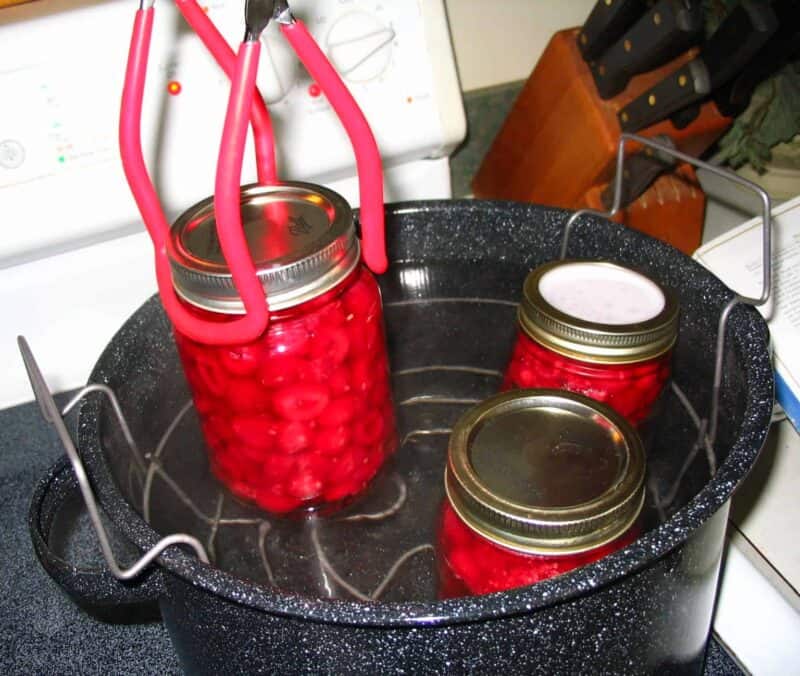
Step 9. Process the jars for 15 min. at a rolling boil:
Step 10. Remove the jars from the canner using a jar lifter, and allow to cool for 16-24 hours before testing the seals. If any of the lids did not seal, place that jar in the fridge to be eaten within a week or so.
Recipe Notes
When making your canned raspberries, be sure to adjust the processing times if you’re canning at altitude.
Also, you can use other sweeteners, like stevia or honey, but make sure you use a different canning recipe that accounts for that to make sure you’re processing the berries safely.
Finally, be sure to label each jar with the date it was made so you know exactly how fresh your jars are when you go to use them!
How to Store Canned Raspberries
It is important to store your canned raspberries properly to ensure that they retain their freshness and flavor. Canned raspberries should be stored in a cool, dark place. The ideal temperature is between 50 and 70 degrees Fahrenheit.
Raspberries can also be stored in the refrigerator, but they should be used within two weeks of opening the can.
When storing canned raspberries, make sure to keep the can closed. This will help prevent the fruit from drying out or developing mold. With proper storage, canned raspberries can last for up to one year.
How To Use Canned Raspberries
Canned raspberries are a delicious and versatile fruit that can be enjoyed in many different ways. They can be eaten as they are, or poured on top of oatmeal, semolina, rice pudding or ice cream. They also make a great topping for pancakes, crepes or waffles.
For something a little more substantial, they can be used to make desserts such as pies or cakes. The juice from the raspberries can also be used to moisten cake bases before filling, giving the cake an extra burst of flavor.
Ultimately, there are many different ways to enjoy canned raspberries, so get creative and experiment until you find your favorite.
Preserving Alternatives to Canning Raspberries
Canning helps to extend the shelf life of the fruit and prevent spoilage and is really my preferred method of storing these fruits. However, canning raspberries can be time-consuming and require the use of specialized equipment.
There are several alternative methods of preserving raspberries that are simpler and do not require any special equipment.
These methods include freezing, dehydrating, and making jam.
Freezing is probably the simplest method of preserving raspberries. All you need is a freezer-safe container and raspberries that have been washed and dried.
Dehydrating raspberries is another easy method that does not require any special equipment. All you need is a food dehydrator or oven set to a low temperature.
Making jam or jellies is a slightly more involved process, but it is still relatively simple. In addition, homemade jam generally has a better flavor than store-bought jams.
Preserving raspberries by one of these alternative methods is a great way to extend their shelf life and enjoy them year-round.
Oh, and of course – you can always just snack on them fresh!
Final Thoughts
So there you have it! Now that you know how to can raspberries whole, get started on your canning project and enjoy these delicious berries all year long.
Have you ever canned whole raspberries? What’s your favorite way to use them?
last update: 08/20/2022 by Rebekah Pierce

A city girl learning to homestead on an acre of land in the country. Wife and homeschooling mother of four. Enjoying life, and everything that has to do with self sufficient living.

How much honey would you use in place of the sugar?
To taste
I assume the 5 1/2 cups of syrup was the correct amount of liquid for 4 pints?
What causes the syrup and berries to flow out of the jars, either while processing them or when they are cooling on the counter? How can I remedy this?
You might have overfilled the jars (not enough headspace), or there might have been air bubbles in the jar. Sorry to hear you had trouble!
Would this work with raspberries that have already been frozen? I’d like to preserve them to last longer than frozen and they’re taking up too much freezer space!
Thanks!
I am wondering the same thing. Can I pull out raspberries from the freezer and can them? Is there a special way to do this? Would I need to process then a little longer to make up for the frozen raspberries?
Hi,
These canned raspberries look delicious! We are looking to do this for Christmas gifts this year, as we have an abundance of raspberries growing in our backyard.
I was hoping to include a nice recipe with the jar for a gift. Do you have a simple recipe that you can share that uses these canned raspberries? Perhaps an ice cream sauce or something?
Thanks!
Kerri
We actually enjoy them swirled in yogurt and ice cream, straight out of the jar. 🙂
as a kid. we had canned raspberries by the dozens and I would just have mine in a bowl with cream. or on ice cream. it’s sweet enough. growing up on this I now have to resort to store bought frozen and I just thaw them and eat straight from the jar.
sincerely,
Nana’s girl
Instead of putting my jars in a dishwasher, etc, to keep warm, I put my jars in the water bath. I tip them to get water inside, and they warm up as the water itself is warming up. I use the jar lifter to get them out of the hot water…and tip the water that is in the jar out. This was recommended in the ball book of canning and preserving. Less work. You should try it!
Good tip, Susan 🙂 I used to keep my jars in simmering water until ready to use, but now I just find it easier to wash, sanitize, and keep them warm in the dishwasher, lol. Whatever works, right? 😉
Wonder if this could be done with blueberries? I was able to get a hold of some wild grown blueberries from a farmer and they have overtaken my freezer! We don’t do jam a lot but having the whole berries would be awesome! Experiment brewing maybe? haha!!
Definitely, Tabatha!!! You can use this recipe for any kind of berry you want to can: blackberries, blueberries, currants, elderberries, huckleberries, etc. (per the Ball Blue Book of Canning) 🙂
It works for saskatoons so it should work for blueberries too.
I canned raspberries last year and this year. I added 1/4 cup sugar to each 4 cups berries and let set 2 hours. Then I heated to a boil and put in jars and water bathed. No need to add water. Use them in homemade ice cream. YUM.
Sounds good, Vicki!
Well this is great. I don’t know why we always think of canning whole or in pieces things like pears and peaches, but not berries. And I hate all the sugar people put in jams/jellies, AND since we don’t eat much bread, we just don’t use much of it.